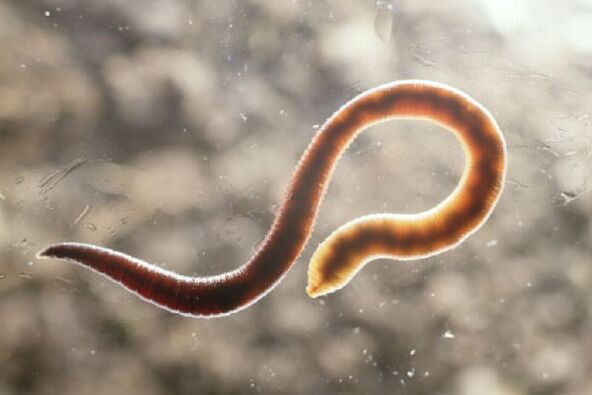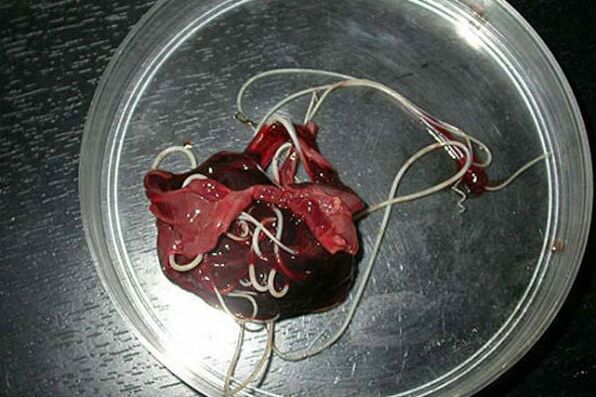
Worms in humans, the symptoms and treatment of which are prescribed by a doctor, are provoked in the human body by two types of worms - round (nematode) and flat (worms and tapeworms). Each of the parasites causes significant damage to the body, especially if proper treatment is not provided in a timely manner.
When you get home, be sure to wash your hands and rinse your vegetables or fruits under warm or hot water, as these are likely to contain parasitic eggs. Products such as fish or beef must be subjected to heat treatment. Due to the high temperature, the meat gets rid of the eggs of various worms and may be fit for consumption.
Species of nematodes
Pinworms are small, grayish-white, parasitic flatworms that induce enterobiasis.
Such parasites enter the human body in the following ways:
- nourishing (through the oral cavity);
- unwashed / dirty hands.
Worm eggs are found in unwashed fruits or vegetables or in the coat of a sick animal. Children who scratch the itchy areas of the skin and then swallow eggs (along with contaminated food, for example) are more likely to become infected with enterobiasis. In the gastrointestinal tract, pinworm larvae develop for two weeks, and after full development, a full-bodied worm survives in each part of the colon.
Trichinella - the round body of these parasites does not exceed 5 mm and they cause trichinosis in the body. Larvae and eggs are preferred in poorly roasted meat (wild boar, pork, bear meat). In the human body, Trichinella takes up to 4 days to reach adulthood and has a life cycle of 40 days. The main purpose of these types of worms is to enter the bloodstream through the intestinal wall and settle in the muscles. In addition, the muscles of the respiratory and musculoskeletal systems are often affected.
Roundworms are large, spindle-shaped with a reddish-yellow tinge. Males of this species reach 15-25 cm and females 40 cm. Their bodies are free from the adaptations needed to fix them in the gut, they only move independently through the intestines to the food mass.
You can become infected with tapeworms if you swallow ripe eggs while eating unwashed vegetables or fruits, which retain the smallest grains of soil. Once the eggs enter the body’s internal environment, adult larvae hatch out of them, terrorizing the intestinal walls. Through the bloodstream, parasites can enter the heart muscle and later the lungs.

This alone does not end the cycle of travel through the body, because the larvae enter the mouth through the airways.
By ingesting the parasite again, the body is already creating a favorable environment for its development.
The path of the full-fledged worm passes through the small intestine. Their life cycle is 12 months, after which they die and are excreted in the feces.
Vlasoglavy - worms in humans, the symptoms and treatment of which are determined at any time after infection, prefer to live directly in the intestines. This worm eats the blood component or feeds on the intestinal mucosa.
Females lay their eggs directly on the wall of the affected organ, then come out with the feces and develop under environmental conditions. Already a mature larva with an elongated body and not exceeding 5-15 mm. it enters the human body through food.
These parasites have a round body of no more than 5 millimeters and stimulate trichinosis in the body. Larvae with eggs are found in poorly roasted meat (wild boar, pork, bear meat).
In the human body, Trichinella takes up to 4 days to reach adulthood and has a life cycle of no more than 40 days. The main purpose of these types of worms is to enter the bloodstream through the intestinal wall and settle in the muscles. In addition, the muscles of the respiratory and musculoskeletal systems are often affected.
Necator / hookworm. The relationship between these parasites is direct in the context of the diseases they cause and the biological signs. They live in the duodenum and, due to their small size (10-15 mm), move freely around it.
Larvae can only enter the body through the skin if someone has been in contact with contaminated soil. Worms also target the lungs and digestive system. They only feed on the blood coming out of the bitten blood vessels. Due to the intense activity of these parasites, blood clotting is disrupted. Adults consume 0, 1-0, 35 ml of blood per day.
Species of flatworms

Wide ribbon. The body length of the parasite, which is 10-20 meters, deserves special attention.
The parasite is derived from freshwater fish and crustaceans, and the larvae enter the eggs and fish fillets.
The adult worm develops for up to 25 days, after which the person suffers from difhyllobothriasis (a digestive disorder, vitamin B deficiency).
Liverwort is a flatworm, reaching 10-20mm in size, and this parasite has a second name - catworm. 50% of infections are caused by residents who have consumed infected fish (carp, crucian carp, bream, cockroach). The fish are infected through a consumed snail with liver flakes that had previously consumed helminth eggs with fresh water.
Cleaning the fish from the parasite requires heat treatment, otherwise the larvae enter the internal environment of the body and damage the gallbladder along with the intestines. Signs of the acute phase of helminthiasis in people are a feeling of nausea that turns into vomiting, pain in the upper abdomen, allergic reactions, muscle cramps. The parasite creates irreversible changes in the body, and even after the patients are expelled from the body, all kinds of inflammation and abnormalities certainly occur.
Pig / bovine tapeworm. The body of the parasite is 5-6 meters long, its larvae hide in the flesh of large animals (pigs, cattle). The disease aroused by such helminths is called teniasis and teniarin.
Both tapeworm species, the larvae of the Finns, are whitish blisters adhering to the wall of the small intestine. It takes 3 months for the parasite to reach and form an adult, and the worm develops every day. The total number of segments reaches 2, 000, with the final freely "grooving" the colon.
The worms then leave the body with the feces through the anus. The most common and most obvious symptom of helminthiasis is a disorder of the digestive system and a large amount of food intake, and the patient does not gain weight visually.
Echinococcus. In this case, a person acts as an intermediate owner because the final ones are wolves, cats, dogs. Animals can become infected through direct contact with infected objects or humans. As soon as the parasite’s eggs enter the intestines, larvae with six hooks develop immediately, which are called oncospheres in medicine.

The worm’s favorite habitat is the lungs and liver, and the larva becomes an echinococcus cyst that grows. All nearby tissues are subject to rapid decay.
Doctors often do not detect echinococcosis and confuse it with a malignant or benign formation. In addition to constriction of blood vessels and internal organs, cysts of the echinococcus cyst are common.
When this happens, not only does a toxic shock occur in the body immediately, but the ruptured cyst also provokes the formation of several new cysts.
The last type of parasite is the alveococcus, called echinococcus in the medical literature. This worm awakens a terrible disease that causes damage commensurate with cancer and cirrhosis of the liver. The oncospheres of the worm enter the intestines, then the embryos hatch from the eggs and begin to destroy the intestinal walls. After drilling the walls, the parasite enters the bloodstream and spreads throughout the body.
Most often, as mentioned earlier, alveococci terrorize the liver, where the larva gradually grows. In the process of development, the larval cyst is formed in the worms - an aggressive formation that grows rapidly (multi-ventricular vesicle, gradually growing). These vesicles enter the liver cells on the same principle as cancer metastases.
Nearby tissues experience a violation of blood flow and later undergo necrotic changes. With such multi-chamber blisters, fibrous nodules form on nearby structures that can remain in the human body for several years. Therefore, doctors resort to surgery when a parasite is detected.
note
Modern science knows about 280 species of worms. These microorganisms can parasitize and develop in various tissues and organs of the human body.
Every year, the organs and tissues of about 15 million people are affected by these human worms, the symptoms and treatment of which are determined by a doctor, and most of them, more precisely 80 percent of them, are children.
How to get worms:
- Use of poorly cooked meat dishes or raw meat in general. So beef is the habitat of the tapeworm and the pig carries the tapeworm of the pig.
- Consumption of infected fish in lightly salted or raw form. The water of the river is often infested with helminth larvae.
- Water can also cause worms. This is due to the fact that a person can drink raw water or wash food and utensils with contaminated water. The risk is particularly high outdoors.
- The soil can also cause worms to appear. Because it may contain animal or human feces. But how do worms get into the human body? The answer is simple - unwashed hands after gardening or relaxing outdoors.

It can also become infected through direct contact with a person with helminthiasis. That is, the infection occurs through dishes, bedding, or personal hygiene items.
If the case is completely neglected and the parasitic infection is in the acute phase of its development, doctors will prescribe detoxification and desensitization therapy. And if the disease is very severe, glucocorticoids are prescribed.
Speaking of specific therapy, it takes into account the nature of the pathogen and contains special anthelmintic chemotherapeutic agents.
In addition, patients must take various antihistamines. You should receive a probiotic treatment at the end of treatment. All this is necessary to restore the intestinal microflora. During treatment, the patient should follow a special diet consisting of easily digestible foods with a minimum fat content.
Adequate personal hygiene is very important during therapy, otherwise there is a risk of re-infection.
In addition, all family members and other persons in constant and close contact with the patient should be treated with anthelmintic.
Signs of worms in humans: symptoms in children and adults
Signs of worms in humans, which may have the same symptoms, can be seen in sharp form in both adults and children:
- Unjustified increase in appetite and copious salivation, while rapid weight loss.
- There may be another variant of the symptoms - the appetite disappears, you feel bad after a meal.
- Maybe the onset of headaches and dizziness.
- Loose stools or constipation may also indicate the presence of worms.
- Abdominal pain.
- Sudden allergy with incomprehensible symptoms.
- Weakening of hair and nails (their fragility increases due to a lack of iron and vitamin B12).
- Due to the weakening of the immune system, various inflammations appear in the nasopharynx and in the genital area.
When the body is heavily infected with worms, large amounts of toxic substances enter the human blood due to the vital activity of helminths. This condition can greatly affect a child’s health. First, the nervous system suffers. Therefore, if the child shows sudden aggression, irritability, insomnia, and other signs of nervous system disorders, the child should be monitored for the presence of helminths.

Even if there are no obvious signs and no functional abnormalities, worms may be present in the human body and regular tests should be performed to identify them.
It is common for a child to have an allergic reaction after preventive vaccinations due to the presence of toxic substances excreted by helminths.
In fact, determining whether or not there are worms is a rather difficult task based on mere superficial signs. After all, the symptoms shown may be signs of another illness. This task is especially difficult for pregnant women. Because the above signs of worms in humans, the symptoms of which are described above, occur in pregnant women because of the process itself.
For this reason, the signs of helminthic infection in pregnant women can be distinguished by the following symptoms: itching in the anus and burning sensation in the vagina, which increase at night, weight loss, fatigue, fever.
A number of measures should be taken to diagnose helminth infection, including the following procedures:
- Collection of medical history to identify potential sources of infection.
- Laboratory testing of stool and blood samples, rectal and perianal mucus, muscle tissue, sputum and bile samples. During these activities, signs of the presence of worms in the body (eggs or the worms themselves and parts of them) can be detected. It is also worth noting that the increased number of eosinophils may be a sign of the presence of worms in the body.
- Serological tests (ELISA, RSK, etc. ) allow the detection of parasites at the stage of larvae or worms in muscle tissue.
- Ultrasound, CT, and endoscopy are prescribed to determine the presence of parasites affecting the liver.
Worms in the human liver: symptoms by type of worm
Worms in the human liver, whose symptoms are highly dependent on the type of helminths, can also migrate to other organs.
The primary signs of worm infection do not appear immediately. The time of onset of characteristic traits depends in many respects on the species composition of the parasites. Thus, the presence of ascaris manifests itself in the deterioration of the general condition of man within almost two to three days.
In most cases, the first symptoms of infection with other types of helminths do not appear until two to three weeks after the end of the incubation period. There are parasites (such as filariasis) in which the incubation period exceeds the six-month limit.
The problem with determining the presence of helminths in the human body is that there are virtually no visual signs of primary infection with a small number of worms or a single individual. Symptoms begin to appear only after intense multiplication of the intestinal worm or when large sizes are reached (broad tapeworm, tapeworm).
The most reliable way to determine a fungal infection. In their presence, a characteristic itching appears in the anus, which intensifies at night. Basically, the itching occurs within a few days, then subsides for about two weeks and recurs.
When infected with helminths such as trichuriasis, ankylostomidosis, schistosomiasis, diphyllobothriasis, beriberi and anemia develop.
The onset of symptoms of a fungal infection is highly dependent on the developmental period of the parasites. So when they are in the early stages of development, the larvae travel through the blood to almost every internal organ, and the following symptoms of the disease appear: subfebrile fever, weakness, cough with purulent sputum, volatile infiltrates are seen on x-rays. the lungs, which later disappear.
In case of severe infection, bronchitis and pneumonia may develop. With the further development of parasites, the functions of the gastrointestinal tract are impaired.
Trichinosis - mainly manifested by muscle tissue pain, fever and swelling.
Such worms in the human liver, the symptoms of which are manifested in icteric facial skin, such as fascioliasis, opisthorchiasis, clonorchiasis, show their presence with the growth of the spleen and liver, as well as other serious disorders of the body.
Almost all types of worms cause central nervous system disorders while the patient feels severe headaches and fatigue, the generally calm person becomes irritable, impatient, and unreasonable attacks of aggression can occur.






































